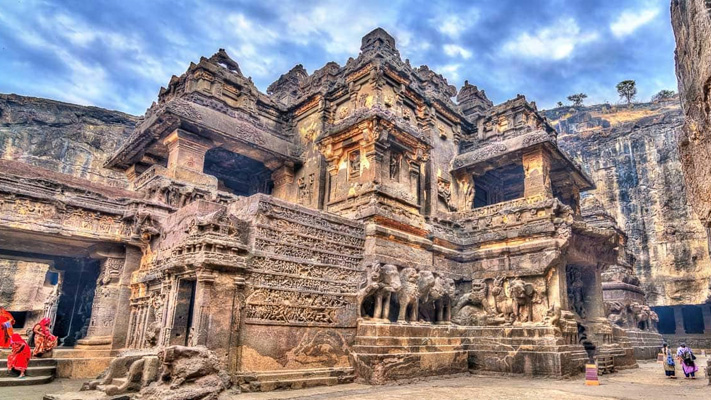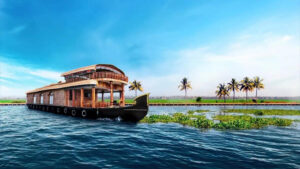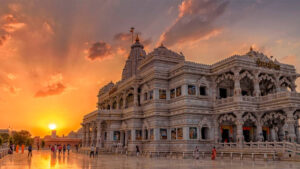AJANTA & ELLORA CAVES – ANCIENT MARVELS OF INDIA’S HERITAGE

Ajanta and Ellora Caves, located in the state of Maharashtra, India, are remarkable UNESCO World Heritage Sites that attract tourists from all over the world. These ancient cave complexes are renowned for their exquisite rock-cut architecture, intricate sculptures, and captivating murals that depict rich cultural and religious narratives.

The Ajanta Caves, dating back to the 2nd century BCE to the 6th century CE, are a collection of 30 rock-cut Buddhist caves nestled within a scenic gorge. These caves showcase magnificent frescoes and sculptures depicting the life and teachings of the Buddha, as well as intricate detailing of mythical beings, celestial nymphs, and other religious figures. The beauty and artistic mastery of the paintings make Ajanta Caves a treasure trove of ancient Indian art.
The Ellora Caves, spanning a timeline from the 6th to the 10th century CE, consist of 34 monasteries and temples carved into the Charanandri Hills. This complex includes structures representing Buddhism, Hinduism, and Jainism, making it a unique site of religious harmony. The highlight of Ellora is the grand Kailasa Temple, the largest monolithic structure in the world, dedicated to Lord Shiva. The intricate carvings, massive pillars, and ornate sculptures are a testament to the remarkable craftsmanship of the ancient artisans.
Ajanta and Ellora Caves are not just archaeological sites but living testaments to India’s rich cultural heritage. They are a must-visit for history enthusiasts, art lovers, and anyone seeking to connect with the spiritual and artistic legacy of ancient India.
Inside the Caves
When you venture inside the Ajanta and Ellora Caves, here’s what you can expect to encounter:
Ajanta Caves:

- Cave Layout: The Ajanta Caves are divided into two main groups: the Hinayana caves (Caves 9, 10, 12, 13, and 15A) and the Mahayana caves (remaining caves). Expect to explore a series of dimly lit rock-cut chambers, interconnected passages, and prayer halls.
- Cave Paintings: The highlight of Ajanta Caves is the stunning cave paintings. As you explore the caves, expect to see vividly colored frescoes depicting the life of the Buddha, Jataka tales, celestial beings, and other mythical figures. The paintings are exceptionally well-preserved and provide a glimpse into ancient Indian art.
- Sculptures and Carvings: Alongside the paintings, you’ll come across intricate sculptures and carvings in the caves. Look out for beautiful statues of the Buddha, Bodhisattvas, and other deities. The sculptures display fine craftsmanship and attention to detail, showcasing the artistic skills of the ancient artisans.
- Buddhist Prayer Halls: Within the caves, you’ll find spacious prayer halls where Buddhist monks would gather for religious ceremonies and meditation. These halls often feature intricately carved pillars and decorative motifs.
Ellora Caves:
- Cave Architecture: The Ellora Caves consist of Buddhist, Hindu, and Jain temples and monasteries, each dedicated to different deities and religious practices. Expect to see impressive rock-cut structures, grand halls, and intricate detailing that vary according to the religious traditions represented.
- Intricate Sculptures: Ellora Caves are known for their impressive sculptural work. Look out for beautifully carved depictions of gods, goddesses, celestial beings, and mythological scenes. The sculptures demonstrate the diversity and artistic excellence of ancient Indian craftsmanship.
- Kailasa Temple: The Kailasa Temple, dedicated to Lord Shiva, is a major highlight of Ellora. As you explore this monolithic temple, expect to be amazed by its sheer size and architectural complexity. Marvel at the intricate carvings, ornate pillars, and detailed sculptures that adorn the temple.
- Varied Religious Influences: One of the fascinating aspects of Ellora Caves is the coexistence of Buddhist, Hindu, and Jain structures in close proximity. Expect to witness the blending of different artistic styles and religious symbolism, showcasing the interplay of cultural and religious influences.
Inside both Ajanta and Ellora Caves, you’ll have the opportunity to witness the artistic and religious marvels created centuries ago. The intricate paintings, sculptures, and architectural details offer a glimpse into the rich heritage and creative prowess of ancient India.
Top Attractions
When visiting Ajanta and Ellora Caves, there are several top attractions and must-visit places that you shouldn’t miss:

Ajanta Caves:
- Cave 1: This cave is the largest and most impressive in the Ajanta complex. It houses beautiful murals depicting scenes from the life of the Buddha and intricate sculptures.
- Cave 2: Known as the “Cave of the Thousand Buddhas,” this cave features numerous Buddha statues in different poses and showcases the artistic mastery of ancient craftsmen.
- Cave 16: This cave is famous for its stunning ceiling painting known as the “Great Miracle of Sravasti.” The intricate artwork portrays the Buddha performing miracles.
Ellora Caves:
- Kailasa Temple (Cave 16): The centerpiece of Ellora, the Kailasa Temple is a masterpiece of rock-cut architecture. Explore its intricately carved walls, pillars, and sculptures dedicated to Lord Shiva.
- Cave 10 (Vishwakarma Cave): This cave stands out for its extraordinary architectural details, including the depiction of various mythological stories and intricate carvings of deities.
- Cave 32 (Indra Sabha): This cave is known for its magnificent sculptures of gods and goddesses, as well as its beautifully carved columns and doorways.
- Cave 21 (Rameshvara Cave): Visit this cave to witness its impressive sculptures, including those of Shiva and Parvati, as well as intricate ceiling carvings.
- Cave 29 (Dhumar Lena): Explore this cave, which is adorned with intricate carvings and features a monolithic shrine of Lord Shiva.
Must Visit Places Nearby
When visiting Ajanta and Ellora Caves, there are a few must-visit places nearby that you can explore:

- Aurangabad: The city of Aurangabad is the gateway to Ajanta and Ellora Caves. It is worth spending some time exploring its attractions, such as the Bibi Ka Maqbara (also known as the “Mini Taj Mahal”), the Aurangabad Caves, and the Daulatabad Fort.
- Grishneshwar Jyotirlinga Temple: Located around 30 kilometers from the Ellora Caves, this ancient temple is dedicated to Lord Shiva. It is one of the 12 Jyotirlingas (sacred abodes of Lord Shiva) in India and holds religious significance.
- Panchakki (Water Mill): Situated in Aurangabad, Panchakki is a unique historical water mill that dates back to the 17th century. It was built to harness the power of water for grinding grains and has an associated mosque and gardens.
- Shirdi: Located about 130 kilometers from Aurangabad, Shirdi is a popular pilgrimage site associated with the renowned saint Sai Baba. Devotees from around the world visit the Sai Baba Temple and seek spiritual solace.
- Lonar Crater: If you have extra time and are interested in unique natural formations, you can consider a visit to the Lonar Crater. It is a stunning meteorite impact crater, located about 160 kilometers from Aurangabad, and is surrounded by a lake and lush greenery.
Best Time to Visit
The best time to visit Ajanta and Ellora Caves is during the winter and early spring months, from November to February. During this period, the weather is generally pleasant, with cool temperatures and mild to no rainfall. Here’s why this time is considered ideal:
- Weather: Winter in the region is characterized by pleasant daytime temperatures ranging from 15°C to 25°C (59°F to 77°F). The weather is generally dry and comfortable for exploring the cave complexes and nearby attractions. It is a relief from the scorching heat of summer.
- Comfortable Exploring Conditions: The caves can involve a fair amount of walking and climbing, so cooler temperatures make it easier to explore without discomfort or excessive sweating.
- Clear Visibility: The winter months typically have clear skies, which enhance the visibility and allow you to appreciate the intricate details of the cave paintings, sculptures, and architectural features.

- Festivals and Cultural Events: The Ajanta-Ellora Festival, a cultural extravaganza featuring performances of music, dance, and other artistic expressions, is usually held in November. Visiting during this time allows you to experience the vibrant cultural heritage of the region.
- Lower Tourist Crowds: Compared to the peak tourist season, which includes summer and monsoon months, winter sees fewer crowds. You can enjoy the caves and nearby attractions with relative tranquility and have better access to facilities and guides.

















































